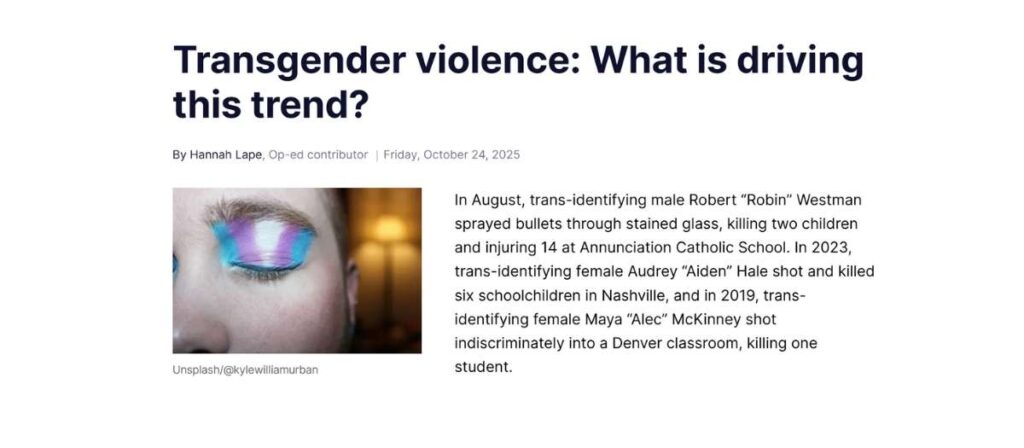In August, trans-identifying male Robert “Robin” Westman sprayed bullets through stained glass, killing two children and injuring 14 at Annunciation Catholic School. In 2023, trans-identifying female Audrey “Aiden” Hale shot and killed six schoolchildren in Nashville, and in 2019, trans-identifying female Maya “Alec” McKinney shot indiscriminately into a Denver classroom, killing one student.
These massacres foment a question: what is driving the seemingly pervasive trend of violence from trans-identifying individuals?
As uncomfortable as it may be, trans ideology in practice must be examined if that question is to be answered. Often, gender transition is a canary-in-the-coalmine for deeper mental illnesses — gender dysphoria, bipolar depression, or PTSD — that manifest as self-hatred. In the face of these genuine mental sicknesses, gender transition offers an “escape” just short of suicide: a new self, a new name, and a new body.
Once a trans-identifying person’s old self is “dead” after social and medical transition, objections to trans ideology are not merely general or intellectual, but personal. To question transgenderism is to question the lives and identities trans-identifying people have individually created and purchased for themselves. Any acknowledgement of the old, dead person to the new, trans-identifying person (for example, using the wrong “pronouns”) is existentially offensive because the old person is “dead.”
Trans ideology has never existed without opposition, but right now, the “existential threat” to transgenderism is growing: “common sense” is making a popular comeback in vocal conservative and Republican circles, the Trump administration flatly rejects trans ideology, and many Americans are realizing that “gender-affirming care” is not healthcare. Trans ideologues took a hit this Supreme Court term, and the majorities in both houses of Congress affirm the administration’s executive order recognizing only two sexes.
Trans-identifying individuals may see these cultural changes as personal attacks — and in the face of “existential threats,” violence is rubber-stamped as a valid defense mechanism. Just a month before Robert Westman opened fire on schoolchildren, Eugene Weekly published its weekly magazine, titled “Are You Triggered?” with the subheading, “As the Trump administration attacks trans people, some queer folks are armed and ready to bash back.” The front page featured a man dressed in women’s clothes, wearing purple eyeshadow and painted nails, and sporting a large semi-automatic rifle.
While some trans-identifying ideologues (like the editors at Eugene Weekly) channel violence in verbal or written fashion, others are incited to actual, physical violence — what else was the Eugene Weekly’s cover intended to incite among an already mentally unstable population other than literally “bashing back” with bullets?
As we grapple with the question of transgender violence as a society, let us first consider that transgenderism itself is born of violence — violence against one’s own body, mind, and soul.
Read the full op-ed at The Christian Post.






